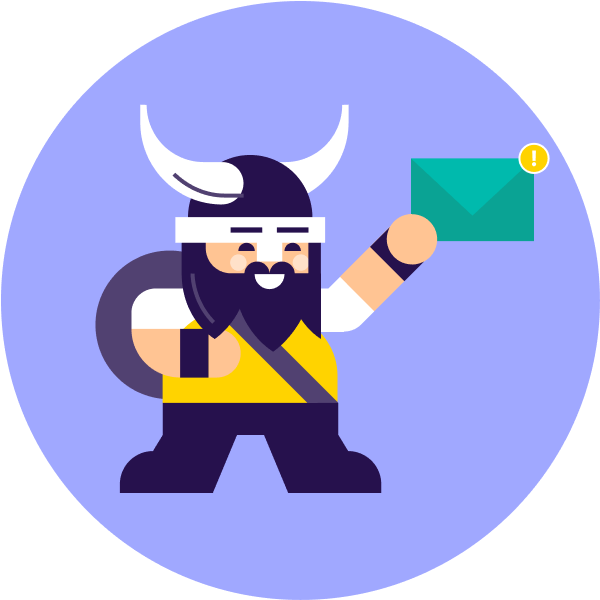The Data Engineers Reference Guide to Marketing APIs
Marketing APIs come in all Shapes & Sizes. Only a Scalable Solution Can Keep Up
Rivery’s Marketing API Benchmark Report is meant as an all-purpose reference guide for data engineers who want to leverage and implement marketing APIs.
In order to do that, data engineers must keep up with the evolving standards of each API. And, as shown in the Report, API updates are very common among marketing APIs.
Just consider the five APIs with the most updates, for a moment, and ignore the rest.
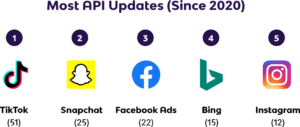
TikTok led the pack with a whopping 51 updates. Snapchat came in second with 25, while Facebook Ads took third with 22. Bing claimed fourth with 15, and Instagram closed out the top five with 12.
If you’re a data engineer that uses all of these marketing APIs — a not uncommon scenario considering the platforms — you’ve had to deal with 125 API updates since 2020. And that’s just counting these five APIs. For teams with limited dev resources, or even decent dev resources, updating each API manually is a massive time sink. Without an ELT platform, your data engineer will either spend most of their time building and updating APIs, or more likely, exercise a form of API triage and go without key data.
The sheer volume and variety of marketing APIs makes them difficult to manage without a dedicated solution. An ELT platform such as Rivery eliminates these burdens by offering pre-built data connectors, automatic API updates, and no backend maintenance. That way, data engineers can harness marketing APIs to focus on insights and analysis, rather than redundant, low-value tasks.
Our global customer base, composed of hundreds of companies in dozens of sectors, also gives us data about how marketing teams are using these APIs. We want to share that data to help data engineers understand how their peers are accessing data via API so they can benchmark their resource investments. From Facebook Ads, to Taboola, to Kochava, and much more, our Marketing API Benchmark Report offers a complete data engineers reference guide for these critical APIs.
Report Methodology
With hundreds of customers, across dozens of industries, Rivery has access to unique data perspectives about how businesses are using marketing APIs. In order to share this market intelligence with our community, we aggregated and anonymized all of the data points published in this report. The following explainer describes our methodology for calculating each of the insights in this book.
Key Insights
Most Popular APIs/Reports: Ranked by the number of Rivery accounts using an API or report.
Most Data Usage APIs/Reports: Ranked by the all-time data throughput for an API or report.
Most Frequently Pulled APIs/Reports: Ranked by average data-pulls per day, at both the API and report level.
API Benchmarks
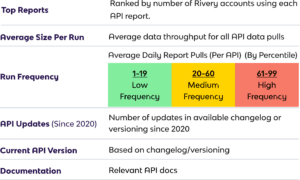
Marketing API Benchmark Report
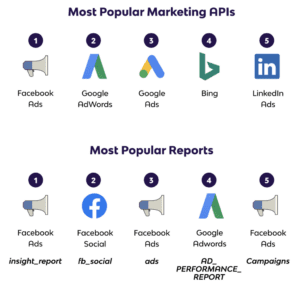
Facebook Ads is the most popular marketing API among our customers, and that comes as no surprise. With 2.7 billion users, and a 3.9% CTR for ads, Facebook remains the premier ad network for B2C and increasingly B2B. In fact, the amount of customers using Facebook Ads is more than double the next closest marketing API, Google Adwords.
As Google currently maintains several marketing API’s, their ranking is skewed by the fact that data must be pulled from many different APIs. But with the AdWords API sunsetting in 2022, the Google Ads API (position three) will absorb many of those AdWords users, and should draw much closer to Facebook’s top spot.
The most interesting entry on this list is Bing, at position four. Bing is the second largest search engine after Google, but only claims 2.71% of the global market share. However, Bing’s average CPC is 70% lower than Google AdWords, and Bing ads reach 63 million users who do not use Google.
The inclusion of LinkedIn Ads, rounding at the list at position five, is expected. As a B2B advertising behemoth, LinkedIn saw its ad reach grow by 25 million people in Q4 2020, when the height of the COVID pandemic and remote work made digital marketing even more essential.
In terms of the most popular reports, Facebook owns the category almost completely, placing with insight_report (position one), fb_social (position two), ads (position three), and campaign (position five). The only other API that claims a top-five report is Google, landing in position four with AD_PERFORMANCE_REPORT in Adwords.
Of course, iOS 14.5 could change everything for Facebook. But right now, Facebook APIs are thoroughly dominant in terms of popularity.
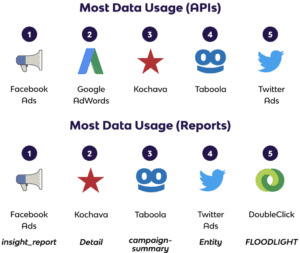
No shocker: the Facebook Ads API claims the most data usage. In position two is Google Adwords, but curiously, Google Ads did not come close to ranking on this list. To quantify the disparity, Google Adwords experienced 569% higher data usage than Google Ads. And yet Google Ads is the third most popular API, by the number of customers using it. This tells us something: customers are integrating Google Ads to prepare for the sunsetting of AdWords, but the bulk of the data is still coming from the AdWords API.
Kochava, at position 3, is an interesting entry. Kochava is a mobile app attribution and analytics platform. Only a handful of our customers use the Kochava API, but those who do rely on it very heavily. The omni-channel platform integrates data from various marketing sources, so instead of pulling from multiple APIs, customers can leverage just the Kochava API for marketing data. The Taboola API maintains a similar dynamic: the number of users is lower, but those who use it do so exceedingly. Twitter Ads, the last API on the top data usage list, has a large number of customers who use the data source moderately.
At the report level, four of the previous five APIs are represented: insight_report (Facebook Ads), detail (Kochava), campaign-summary (Taboola), and entity (Twitter Ads). These are the bedrock reports that help drive data usage for those APIs so high.
However, FLOODLIGHT is a part of DoubleClick, an API that is not represented on the top data usage list. Some of the other DoubleClick reports, such as STANDARD, also draw significant data usage. But since DoubleClick only offers five reports, compared to 27 for Google Adwords, the API’s overall data usage doesn’t crack the top five.
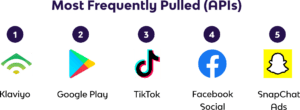
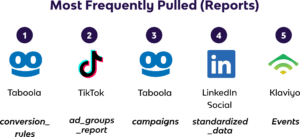
In an interesting twist, Klaviyo — an SMS and email automation platform for ecommerce — is the most frequently pulled API. Klaviyo’s events is the fifth most frequently pulled report across all APIs. Customers who use Klaviyo need fresh data to generate conversions. Also notable, in the second position, is the Google Play API. A handful of accounts are using its agg report very frequently, skewing the API results.
As the third most frequently pulled API, TikTok’s position is driven primarily by the ad_groups_report, the second most frequently pulled report. However, the rest of the TikTok’s reports are in the medium-frequency to low-frequency range. The Facebook Social API appears at position four, driven by the fb_social report. SnapChat Ads rounds out the API list at position five, due to the ad_stats and ad_squad_stats report.
The most frequently pulled reports look a bit perplexing next to the API list. Three of the reports are not associated with any of the listed APIs. In the case of Taboola, this is explained by the fact that both conversion_rules and campaigns are not used by many accounts. So even though these reports are pulled frequently, other reports associated with the Taboola API are not, explaining why Taboola doesn’t make the API list.
The same is true of standardized_data in LinkedIn Social. A few accounts are pulling this report very frequently, but at the API-level, the pulls are not large enough to be significant. That’s why, unlike the Most Popular and Most Data Usage lists, the Most Frequently Pulled list differs markedly between the API and report level.
API Benchmarks
AdRoll
AdRoll | |
Top Reports | 1. report_campaigns |
Average Size Per Run | 0.26 MB |
Run Frequency | Low Frequency |
API Updates (Since 2020) | 0 |
Current API Version | v1 |
Documentation |
The AdRoll API allows data engineers to automate tasks that they usually do on the AdRoll platform. Data engineers can also integrate the AdRoll API into their existing workflows. For example, data engineers can write a script that bulk imports ad creative into AdRoll or automatically add new emails to a CRM audience once a week.
The CRUD API provides most of the functionality found in AdRoll. The CRUD API is implemented as JSON over HTTP using all four verbs (GET, POST, PUT, DELETE). Each resource, like Advertisers, Campaigns, Ads, has its own URL and is manipulated in isolation. The API follows REST principles as much as possible.
AppsFlyer
AppsFlyer | |
Top Reports | 1. in_app_event_report 5. organic_install_report |
Average Size Per Run | 43.6 MB |
Run Frequency | Medium Frequency |
API Updates (Since 2020) | 5 |
Current API Version | v5 |
Documentation |
AppsFlyer’s Pull API enables advertisers to sync all of their AppsFlyer attribution and marketing analytics data with their internal data platforms. The API allows data engineers to use URIs to get AppsFlyer aggregate reports in CSV files.
The URI templates are available in the AppsFlyer Dashboard. Team members get reports by pasting URIs in their browser. BI developers get reports by embedding the URIs in scripts. API calls return a maximum of 200K rows. Pull API reports don’t support campaign name changes.
Apple Search Ads
Apple Search Ads | |
Top Reports | 1. Searchterms |
Average Size Per Run | 32.645 MB |
Run Frequency | Medium Frequency |
API Updates (Since 2020) | 2 |
Current API Version | API 4 |
Documentation |
Apple Search Ads runs ads for apps within the Apple App Store. With Apple Search Ads Campaign Management API 4, data engineers can build campaigns with budgets and daily caps, and create ad groups that include keywords, Creative Sets, audience refinement criteria, and scheduling.
Data engineers can implement their own keyword-bidding strategy in their Ad Groups, or use the Search Match feature to automatically match an ad to relevant user searches in the App Store. Promote campaigns to multiple countries or regions, and generate Reports with meaningful metrics.
Apple Search Ads Campaign Management API 4 is the current version. Data engineers can use calls from the current API to access all of your resources that you created in Apple Search Ads Campaign Management API 3.
Bing Ads
Bing Ads API provides a programmatic interface to Microsoft Advertising, an advertising platform used to display ads based on the keywords contained in a user’s search query on Bing. The Bing Ads API is the most efficient way to manage many large campaigns or to integrate marketing ads with other in-house systems.
The Bing Ads API also supports multiple customer accounts making it easy for ad agencies to manage campaigns for many clients.
Data engineers can develop Bing Ads API applications with any programming language that supports web services. The Bing Ads API Software Development Kits (SDK) enhance the experience of developing Bing Ads API applications with .NET, Java, PHP, and Python languages. The Microsoft Q&A forum is available for the developer community to ask and answer questions about the Bing Ads APIs and Microsoft Advertising Scripts.
DoubleClick
In 2018, DoubleClick became Google’s Display and Video 360, now leveraged through Google’s Campaign Manager 360 API. The Campaign Manager 360 API provides programmatic access to information from a developer’s Campaign Manager 360 account.
The API is used to manage and create campaigns and reports, just as a data engineer would through Campaign Manager 360 and Report Builder web services. Data engineers can manipulate popular DoubleClick reports, such as FLOODLIGHT and STANDARD, via the API.
Facebook Ads
Data engineers can leverage Facebook Ads via Facebook’s Marketing API. The Marketing API is an HTTP-based API that data engineers use to programmatically query data, create and manage ads, and perform a wide variety of other tasks on Facebook. From automated ads management and dynamic creative to targeting and optimization, the Facebook Marketing API unlocks new dimensions for a business.
Since the API is HTTP-based, it works with any language or software that supports HTTP, including cURL and almost all modern web browsers. The Marketing API is built on top of Facebook’s Graph API, so almost all requests should be passed to the graph.facebook.com host URL. Since 2020, the API has been updated frequently in response to Apple’s iOS 14 update and new functionality such as SKAdNetwork.
Facebook Social
Facebook Social is accessed via Facebook’s Graph API. The Graph API is the primary way to get data into and out of the Facebook platform. It’s an HTTP-based API that apps can use to programmatically query data, post new stories, manage ads, upload photos, and perform a wide variety of other tasks.
Typically data engineers use nodes to get data about a specific object, use edges to get collections of objects on a single object, and use fields to get data about a single object or each object in a collection. The Graph API has multiple versions with quarterly releases. Read more about versions in the Versioning guide and learn about all available versions in the Graph API Changelog.
AdWords
Google AdWords | |
Top Reports | 1. AD_PERFORMANCE_REPORT 5. ADGROUP_PERFORMANCE_REPORT |
Average Size Per Run | 63.74 MB |
Run Frequency | High Frequency |
API Updates (Since 2020) | 0 (Sunsets April 27th, 2022) |
Current API Version | l v201809 |
Documentation |
The AdWords API allows apps to interact directly with the Google Ads platform, vastly increasing the efficiency of managing large or complex Google Ads accounts and campaigns. Some typical use cases include:
Automated account management, Custom reporting, Ad management based on inventory, Manage Smart Bidding strategies
With the AdWords API you can build software that manages accounts from the customer level down to the keyword level. The API can do almost everything the Google Ads UI does, but programmatically. The AdWords API relies on SOAP and WSDL technologies to offer its services. To help you get started, we offer client libraries in Java, .NET, Python, PHP, Perl, and Ruby.
The AdWords API will sunset on April 27, 2022. Migrate to the Google Ads API to take advantage of the latest Google Ads features.
Google Ads
The Google Ads API is the modern programmatic interface to Google Ads and the next generation of the AdWords API. The Google Ads API exposes both standard JSON REST endpoints and a high-performance gRPC interface. Google provides pre-built client libraries to get developers started in the following languages: Java, C#, PHP, Python, Ruby, Perl.
With the Google Ads API you can build software that manages accounts from the customer level down to the keyword level. The API can do what the Google Ads UI does, but programmatically. Types of companies that can benefit from the Google Ads API include:
- Ad agencies
- Search Engine Marketing (SEM) companies
- Big brands managing a large number of accounts, with needs beyond the capabilities of the Google Ads UI
Google Play
The Google Play Developer API is a REST-based web service that allows data engineers to perform publishing and app-management tasks. Data engineers can use this API to integrate publishing operations with release-management processes. Using the Google Play Developer API, data engineers can automate a variety of app-management tasks, including:
- Uploading and releasing new versions of an app
- Editing your app Google Play Store listings, including localized text and graphics
- Managing in-app product catalogs, product purchase statuses, and app subscriptions
The Google Play Developer API lets data engineers focus on designing and developing apps, by spending less time and effort managing releases.
HasOffers
The HasOffers Affiliate API offers many functions of the HasOffers platform to end users. The API allows partners to programmatically access their HasOffers accounts directly, outside of the platform. By interacting directly with the API, affiliates can create and embed powerful widgets within their own applications.
HubSpot
HubSpot’s APIs — including Deals, Contacts, and Companies — are designed to enable data engineers of any shape or size to build robust integrations that help them customize and get the most value out of HubSpot. All HubSpot APIs are built using REST conventions and designed to have a predictable URL structure. They use many standard HTTP features, including methods (POST, GET, PUT, DELETE) and error response codes. All HubSpot API calls are made under https://api.hubapi.com and all responses return standard JSON.
Client libraries are designed to help data engineers interact with the HubSpot APIs with less friction. They are written in several different languages and help bridge the gap between application and HubSpot’s APIs. They take away the need to know the exact URL and HTTP method to use for each API call, among other things, leaving data engineers more time to focus on making an application. Learn more about Hubspot’s client libraries here.
The Instagram Graph API allows Instagram Professionals — Businesses and Creators — to use a third party application to manage their presence on Instagram. The API can be used to get and publish media, manage and reply to comments on media, identify media where @mentioned by other Instagram users, find hashtagged media, and get basic metadata and metrics about other Instagram Businesses and Creators.
The API is intended for Instagram Businesses and Creators who need insight into, and full control over, all of their social media interactions. The API is built on the Facebook Graph API.
Klaviyo
Klaviyo | |
Top Reports | 1. events |
Average Size Per Run | 749.92 MB |
Run Frequency | High Frequency |
API Updates (Since 2020) | v1 (v2 for lists) |
Current API Version | v8 |
Documentation |
Klaviyo has two core sets of HTTP APIs that serve two distinct purposes:
- Track & Identify. Used to send event & profile data to a developer’s Klaviyo account. These APIs are designed for high volume & low latency, do not adhere to REST principles, and require the developer’s Public API key/Site ID.
- RESTful APIs. Used to manage objects & query data within a Klaviyo account. These APIs are organized around REST, and use the developer’s Private API Keys for authentication. RESTful APIs can access Klaviyo resources such as: Metrics, Profiles, Lists & Segments, Data Privacy, Campaigns, Templates.
Kochava
The Kochava platform provides extensive tools to track everything from impressions throUgh post-install events for connected devices. The API reporting method provides advertisers with the programmatic tools to gather performance data on an on-demand or schedUled basis. For clarity, see support documentation for API v1.4, divided into the following sections:
- Call Structure
- Querying API
- Requesting ans Scheduling Reports
LinkedIn Ads
Advertising on LinkedIn helps businesses of any size achieve their goals. Target a unique audience – Over 690M active professionals are on LinkedIn. Target them by job title, function, industry and more.
LinkedIn’s Campaign Management functionality gives developers API access to ad campaigns for programmatic manipulation. Create, manage, and optimize ad campaigns at scale using LinkedIn’s adAccountsV2 API.
LinkedIn Social
LinkedIn Social | |
Top Reports | 1. get_posts 5. organization_page_statistics |
Average Size Per Run | 1.99 MB |
Run Frequency | Medium Frequency |
API Updates (Since 2020) | 1 |
Current API Version | v2 |
Documentation |
LinkedIn offers a Shares and Social Stream API Platform through which members can share content and insights with their professional network. Shared content can be personal shares or organization shares and is distributed to members through the network updates stream.
The network updates stream is a rich and engaging real-time feed of content and changes in a member’s first and second-degree network. Viral interactions and activities in the stream create additional distribution opportunities across the larger network of professionals on LinkedIn.
Pardot
Pardot | |
Top Reports | 1. visitor_activities |
Average Size Per Run | 0.04 MB |
Run Frequency | Medium Frequency |
API Updates (Since 2020) | 2 |
Current API Version | v5 |
Documentation |
Data engineers can use version 5 of the Pardot API to read and update a variety of assets and objects, like File and Layout Template objects. For information about other objects that aren’t available in version 5, see the documentation for versions 3 or 4. Data returned by version 5 endpoints is not real-time, so creates and updates may be delayed when reading and querying data.
The Pinterest Marketing API programmatically implements the Pinterest website UI functionality, and allows users to draw from a number of Ads Reporting capabilities, including creating and running ads, campaign measurements, audience targeting, and a wide range of other ads activities.
Salesforce Marketing Cloud
The SF Marketing Cloud REST API enables data engineers to gain broader access to Salesforce Marketing Cloud capabilities. The REST API uses JSON request and response bodies and resource endpoints to support multi-channel use. All new Marketing Cloud technologies implement the REST API. REST calls are synchronous, with timeout values of 120 for non-tracking operations and 300 seconds for tracking and data retrieve operations.
Use the REST API for this functionality:
- Contacts
- Content Builder
- Journey Builder
- Mobile Connect
- MobilePush
- Campaigns
- Triggered Sends (may also use SOAP)
The maximum payload of any call is four megabytes.
Snapchat
Snapchat has made its Marketing API available to any data engineer (agency, brand, technology vendors, or individual) interested in building ad solutions for the platform. The API may be a good fit for businesses interested in building a specific advertising use case that is not available through Ads Manager. Learn how to activate access to the Snapchat Marketing API.
Data engineers can access any platform function through the API, except:
- Organic Snap management
- Organic Snap analytics
- Ability to buy or report on reserved buy
- Attribution / measurement
For a more comprehensive explanation of the API, visit Snapchat’s API overview.
Taboola
The Taboola Backstage API is a RESTful API that allows data engineers to manage Taboola campaigns, run reports, and automate tasks. The Backstage API offers full control of a data engineers’ campaigns. Data engineers can edit campaign settings at any time, including targeting, budget and CPC bid. Start and stop campaigns at any time. The API also offers comprehensive reporting. Gain full transparency into campaign performance, to take the steps to optimize and scale Taboola campaigns.
TikTok
TikTok | |
Top Reports | 1. ads 3. ads_report 5. ad_group |
Average Size Per Run | 2.78 MB |
Run Frequency | High Frequency |
API Updates (Since 2020) | 51 |
Current API Version | V1.2 |
Documentation |
The TikTok Ads Marketing API allows data engineers to directly interact with the TikTok Ads Manager platform for automated ad management and analysis. typical use cases include:
- Getting customized ad performance data
- Creating and managing ads in bulk
- Automating ad optimization
Before data engineers can begin developing with the TikTok Marketing API, they must first create an App. When creating an App, data engineers can specify the permission scope the App will require. After the App has been created, data engineers can then begin working with Advertisers. Here are some related links to get started:
Twitter Ads
The Twitter Ads API connects data engineers to Twitter’s advertising platform to build solutions to meet the needs of Twitter’s advertisers around the world.
With the Twitter Ads API, data engineers can programmatically create, schedule, and manage ad campaigns to engage people on Twitter. Create and manage Tailored Audiences using Twitter, web, or mobile data.
The API can draft and publish Tweets, extend the functionality of Tweets with Cards, and manage and upload images and videos. Use async and synchronous API endpoints to retrieve granular insights of ad campaigns by a full range of metrics. Access the API with Twitter’s curl-like command line tool, twurl.
